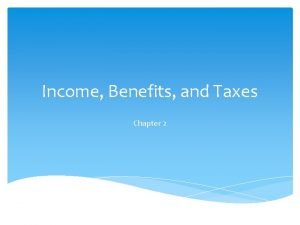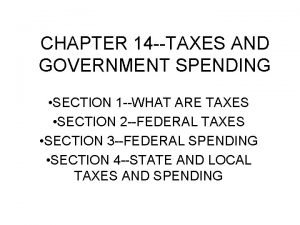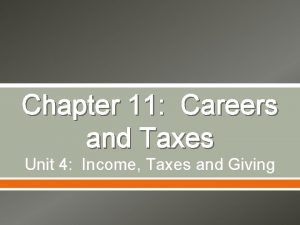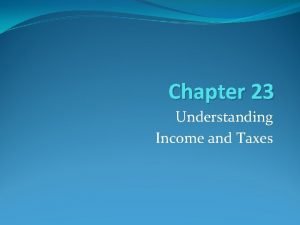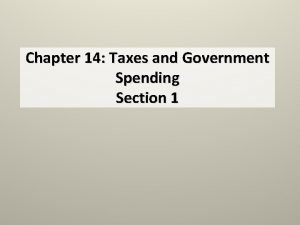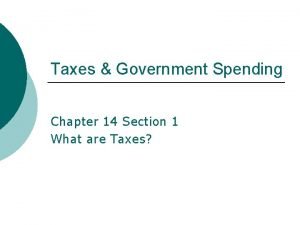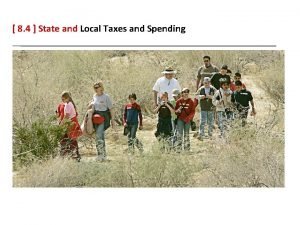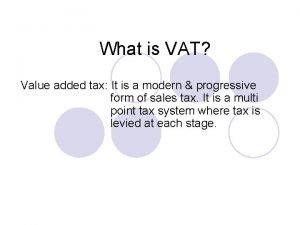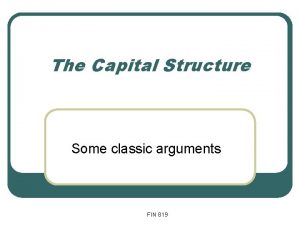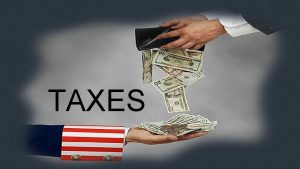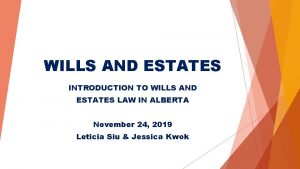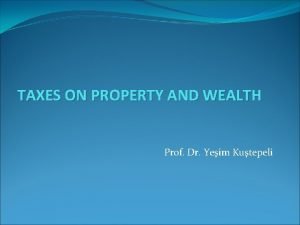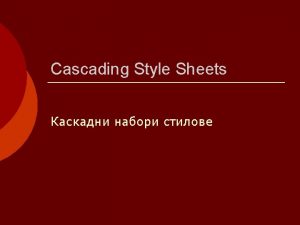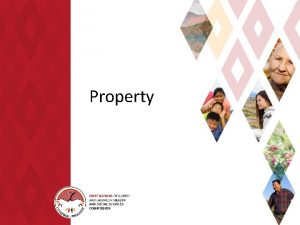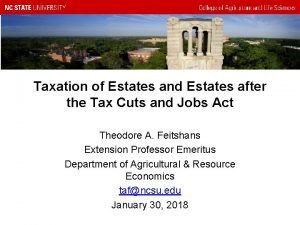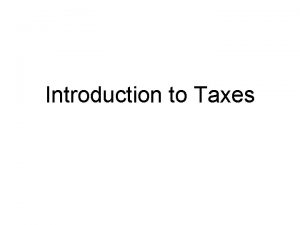Chapter 17 Taxes on Wealth Property and Estates


















- Slides: 18

Chapter 17 Taxes on Wealth Property and Estates 1

A Comprehensive Wealth Tax Base n Real Property is property such as land the structures on the land. n Intangible Property is wealth that is held as paper or financial assets. n Personal Property is wealth that is held in the form of cars, furniture, clothing, jewelry, etc. 2

Measuring Wealth n Market value can be used to establish the value of most real property and intangible property, but personal property has no acceptable resale market. n Serious inequities can arise from mismeasurement of wealth and serious shifting can take place when one form of wealth is taxed while another is not. 3

Assessment of Property Value n For the property tax, the assessed value of a home and the land upon which it sits is quite subjective. Real-estate markets exists for many homes but not others. 4

A Comprehensive Wealth Tax A comprehensive wealth tax would tax all forms of capital equally. If W = Ri/(1 + r)i then the effective tax rate on savings would be ts = t. WW/Ri Where n Ri = the return to asset I n r = the interest rate n t. W = the wealth tax rate n W = Wealth 5

Figure 17. 1 Impact of a General Wealth Tax When the Supply of Savings is Perfectly Inelastic Return (Percent) S r. G * t. W W Ri r. N * D = r. G t. W W r. N = r. G – R 1 0 Q 1 Annual Savings and Investments 6

Figure 17. 2 Impact of a General Wealth Tax When the Supply of Savings is Responsive to Changes in Annual Return (Percent) S r. G 1* r. G * r. N 1* D = r. G t. W W r. N = r. G – R 1 Q 2 Q 1 Annual Savings and Investments 7

Selective Property Taxes n Property Taxes in the U. S. are typically selective in that real property is taxed, some forms of personal property are taxed, and intangible property is not taxed. 8

Wealth Taxes in an Open Economy n n Capital mobility has increased dramatically in recent years. Wealth taxes in a nation discourage foreign investment in that nation. U. S. gross investment has declined from 22% of GNP in 1959 to 17% in 1999. U. S. net foreign investment is negative, meaning that foreign capitalists are investing more in the U. S. than U. S. capitalists are investing abroad. 9

Local Property Taxes and Tax Capitalization n Property Tax Differentials are the differences between what would be owed in one community on a particular piece of property relative to what would be owed on an identical piece of property in a different community. n If the differential is high, then people will be willing to pay less for property in the high-tax community and more for a home in the low-tax community. The tax differential will be capitalized into the value of each home. The present value of the differential over the expected length of time the differential will hold will be the difference in the prices of the two pieces of property. 10

Rent per Square Foot (Dollars) Figure 17. 3 Impact of a Property Tax on Housing Rents S 120 DY 100 t. Vt = $60 60 D=Gross Rent Net Rent = Yt-t. Vt 0 Q 2 Q 1 Housing Rented per Year (square feet) 11

Capitalization and the Elasticity of Supply n Full tax capitalization only occurs if there is no supply elasticity. n Land is perfectly inelastic but structures are not. n A differential tax will cause more building in one area and less building in another. n After such shifting, less than full capitalization of the tax differential occurs. 12

Property Taxes in the U. S. n n n Fractional Assessment is the practice of assessing a property at only a fraction of its true value. Typically this implies that the tax rate is higher. Nominal Tax Rates are the rates of tax per assessed value that a property owner must pay. Effective Tax Rates are defined as the taxes owed per true market value. For instance, Newark N. J. has a nominal tax rate of 23. 85%, but the assessed value of a piece of property is typically only 16. 4% of its market value. Thus, the effective rate is 3. 91%. The average U. S. effective rate is 1. 67%, the median 1. 42%. 13

Reliance of the Property Tax by Local Governments n The property tax is an important source of revenue for most local governments. n It raises more than 95% of all local revenue in CT, ID, MA, MN, MT, NH, NJ, RI, VT, WI. n In no state does it provide less than a third of local government revenue. 14

Property Tax Preferences n Communities often enact “circuit-breakers” that do not allow assessed evaluation to increase more than a fixed percentage in a period of time to help the elderly living on fixed incomes. n Agricultural land is also taxed at a much lower rate than residential and commercial land. 15

Land Taxes n A criticism of property taxes is that they reduce the incentive to build on a piece of property. n A solution is to impose a tax on the land rather than the buildings on it. 16

Figure 17. 4 Impact of a Land Tax Rent per Acre S R*G t. V R*N Entire Tax Borne by Landlords D = RG RN = RG – t. V Q 1 Usable Acres of Land 17

Estate and Gift Taxes n The estate tax places a tax on the estate of those who have died before their assets may be transferred to theirs. n The gift tax prevents people from avoiding the estate tax by giving away their assets before they die. You may give up to $10, 000 to each person per year. n Estate taxes were substantially reduced in 2001. 18
 Chapter 2 income benefits and taxes
Chapter 2 income benefits and taxes Chapter 14: taxes and government spending section 1
Chapter 14: taxes and government spending section 1 Foundations u.com
Foundations u.com Chapter 23 understanding income and taxes
Chapter 23 understanding income and taxes Chapter 14 taxes and government spending
Chapter 14 taxes and government spending Chapter 2 financial statements taxes and cash flow
Chapter 2 financial statements taxes and cash flow Chapter 14 taxes and government spending
Chapter 14 taxes and government spending Accounting income vs taxable income
Accounting income vs taxable income Income tax expense
Income tax expense Classification of property law
Classification of property law Chemical property definition
Chemical property definition State and local taxes and spending
State and local taxes and spending Commutative vs associative
Commutative vs associative Payroll liabilities journal entry
Payroll liabilities journal entry Industrial estate,
Industrial estate, State any two objectives of industrial estate
State any two objectives of industrial estate Benefits of vat
Benefits of vat Mm proposition ii with taxes
Mm proposition ii with taxes How much does wanda earn per hour?
How much does wanda earn per hour?
